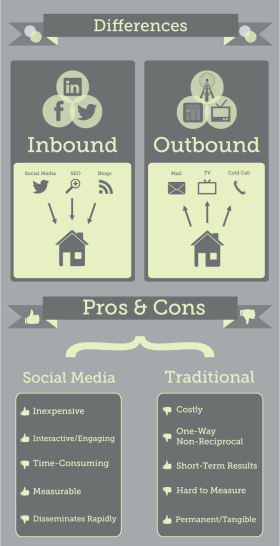
Below are two aspects of marketing that will be looked at a little more closely for both Traditional Marketing and Social Media Marketing.
Classic Marketing v. Social Media Marketing
The social media world is opening doors for companies to generate revenue from a platform that was not even a consideration a few short years ago. Social media is really a paradigm shift or change in worldview rather than simply a new set of tactics2. Marketing via social media is new to most companies, and many advertisers are in the process of figuring out how social media fits in to their overall media mix.
Not only are the audiences different for every platform so is the execution lead-time, reach, and creative restrictions. I am a true believer in multi-platform marketing and how both classic and social media marketing truly can compliment each other if executed properly. During campaign analysis, I usually find that the metrics are greater when you use multiple media platforms to work together versus choosing one over the other to advertise. That’s not to say that the media landscape always should have a true integrated marketing approach because with most things it depends on the objectives of the campaign in question. For example, if you have a marquee campaign that includes a sweepstakes, television is a great driver for sweepstakes entries over social media drivers. Time and time again, television wins when a brand or company is measuring entries to the sweepstakes layer of their marketing plan. The audience still isn’t there on social to move the needle like we see in TV.

Type of Marketing
Traditional marketing has always been about brand awareness and having the media platforms push advertising campaigns out into the world for people to consume. Due to the lead time necessary for traditional advertising, brand messages aren’t very flexible — they don’t change often, media buys are committed far in advance, and brands can’t easily adjust to take advantage of new opportunities2. Especially with television or print platforms, the production schedule is usually more than 8 weeks to produce. A traditional media plan is time-consuming mostly on the front end (planning, creating and buying) and back end (quantifying and analyzing) of the campaign. Once a traditional media plan is put into place, it is a mostly hands-off affair3. The guidelines and stakeholders that have to review television ads are far more extensive than social media posts and campaigns.
With a growing plethora of social media options, which are far less costly than traditional media, some of you might be questioning spending money on those pricey TV, radio and print ads to encourage business. However, using both media together, as opposed to one versus the other can move your message further and reach a larger audience3. These days every company has a social media footprint, and exploring how to utilize the platform. Because social media is new to the media mix, companies are testing reach and engagement from Twitter chats and brand awareness campaigns. Companies and advertisers are experimenting with the types of posts that resonate with their audience to generate more likes, comments and shares. The good news is that because social media is an emerging platform, the cost to execute a social campaign is considerably less than that to produce a television spot.
Unlike traditional media campaigns, a social media campaign needs to be worked every day. Monitoring what your customers are saying and doing and then responding accordingly takes time. Most experts’ recommend spending one hour every day with each social media outlet you utilize3.
Language
Traditional marketing goes through many rounds of review with various stakeholders that could include the creative director, legal, standards and practices, brand franchise, or sweepstakes administrator. It is a very formal process and strict to keep the marketing language adhering to the guidelines set forth by the networks and advertising sites. Additionally, the marketing message is more reflective of full thought out clever tag lines or messages. When you look at social media the marketing lingo changes slightly. Everything is abbreviated, shortened, or just a small piece of the overall marketing campaign is shared. Social media also asks the audience their opinion and phrases the marketing language in such a way that it promotes responses to the posts which is true to the platform in having an open two way communication. Social campaigns are still planned in the initial stages of posts people post in response to the marketing posts.
What Should You Do?
With any strategic marketing campaign, you must first know what the goals are and what the advertiser will deem a measurement of success. Once you know their objectives you can start building a marketing campaign to fit their needs and hope to deliver results to meet their expectations. Is the advertiser looking to grow followers? Are they looking for brand awareness? Do they want to create an experience with their brand. These are all very important questions to ask at the launch of any campaign execution.
Thanks for reading!
Links:
